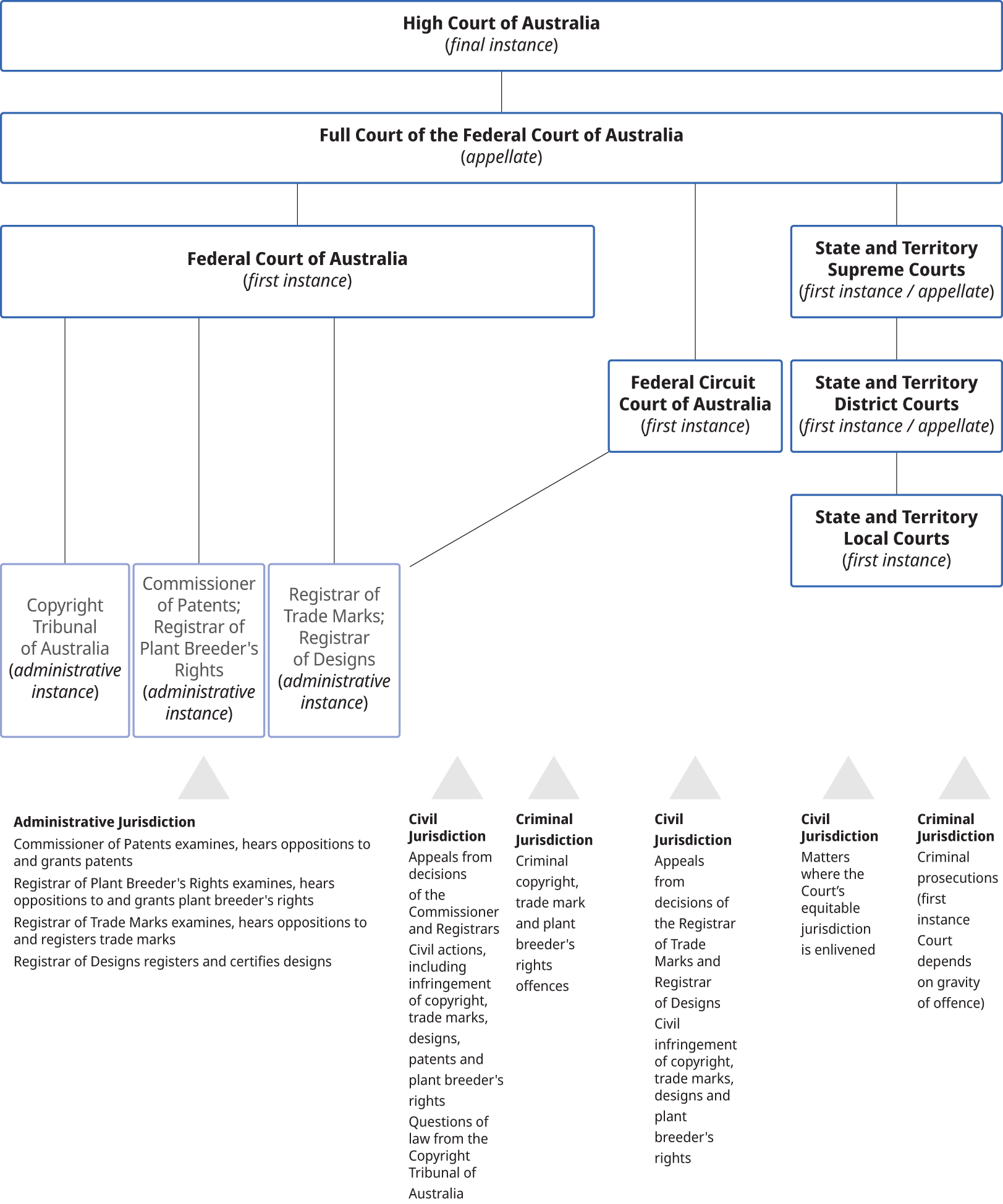2.3.1 Judicial administration structure
2.3.1.1 National judicial structure
Almost all patent infringement and revocation proceedings are heard in the Federal Court of Australia. As a matter of theory, state and territory supreme courts also have jurisdiction to hear such proceedings, although this rarely occurs. Appeals from decisions of the Commissioner of Patents, who is responsible for granting patents under the Patents Act 1990 (Cth), are heard by the Federal Court. All appeals from first-instance infringement and revocation decisions, or from Federal Court decisions made with respect to decisions of the Commissioner, must be heard by the Full Court of the Federal Court.
The Federal Court is composed of a Chief Justice and judges who are appointed from time to time. It is a national court with registries located in each capital city and operates under a policy known as the National Courts Framework. A key feature of the National Courts Framework is the organization of matters filed in the court into national practice areas (NPAs) and subareas. One of the NPAs is Intellectual Property, which has a subarea dedicated to disputes relating to patents and associated statutes. Presently, there are 15 judges who are allocated to the Patents and Associated Statutes subarea of the Intellectual Property NPA. Many of these judges have extensive experience in the conduct of patent trials, as a result either of their work in practice before being appointed to the court or since their appointment. As a general rule, once a case is allocated to a particular judge, that judge retains that case in their docket through the case management, to hearing and judgment.
Individual judges are principally situated in their local registry; however, they are able to hear matters filed in different state or territory registries. Each registry is staffed by registrars and support staff, including lawyers, senior coordinators, client service officers and court officers. In addition to providing operational support to the judges in each state, registrars perform statutory functions assigned to them by the Federal Court of Australia Act 1976 (Cth) and the Federal Court Rules 2011 (Cth). These registrars often have expertise in intellectual property matters, including patents, and provide assistance to judges during the interlocutory phases of case preparation. Where the parties to a patent dispute agree to a mediation being facilitated by a registrar, a registrar with experience in patent cases will frequently be allocated. In addition, registrars will often provide assistance in the preparation of the joint expert report by facilitating the meeting of the experts. Furthermore, disputes relating to the production of documents or costs and other such matters may be delegated to registrars for adjudication. The registries also provide registry services to legal practitioners and members of the public, including by providing information regarding the practices and procedures of the court.
Individual judges of the Federal Court sit at first instance and also as appellate judges. Appeals from decisions of a single judge of the Federal Court, or from decisions of state or territory supreme courts, are heard by the Full Court of the Federal Court, the appellate division of the Federal Court. The Full Court is typically composed of three judges of the Federal Court who are selected for each appeal. Where an appeal is challenging the correctness of a previous decision of the Full Court, an expanded bench of five judges may be constituted.
Appeals from the Full Court of the Federal Court are heard by the High Court of Australia. The High Court is a separate court composed of a Chief Justice and six judges. In order to have an appeal heard by the High Court, parties are required to make an application for special leave to appeal. Special leave applications are determined on the papers or at short contested hearings usually heard by one or two judges of the High Court. If special leave to appeal is granted, the matter will be heard and determined by the Full Court of the High Court, which will usually be composed of between three and seven judges. There is no avenue of appeal beyond the High Court.
Figure 2.2 shows the judicial administration structure in Australia.
Figure 2.2 The judicial administration structure for IP in Australia

Source: Judicial Administration Structure for IP Disputes provided by the Federal Court of Australia, available at https://www.wipo.int/en/web/wipolex/judicial-administration-structure/au
2.3.1.2 Selection process
Judges of the Federal Court of Australia are appointed by the Governor-General of the Commonwealth of Australia by commission. Judges are appointed from the ranks of qualified legal practitioners of significant standing in the legal community. They are most typically appointed from the ranks of barristers or, less frequently, solicitors, who have practiced law for decades before being appointed. All Federal Court judges must retire at the age of 70 years.
Judges of the Federal Court exercise the judicial power of the Commonwealth and are independent from Parliament and the executive branches of the government. As the Federal Court is a court created by Parliament under Chapter III of the Constitution, judges may not be removed from office except by the Governor-General on an address from both houses of Parliament in the same session on the ground of proven misbehavior or incapacity.